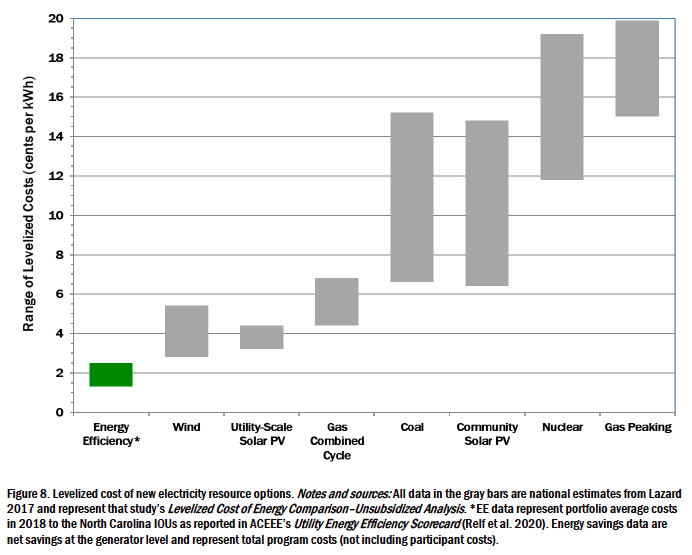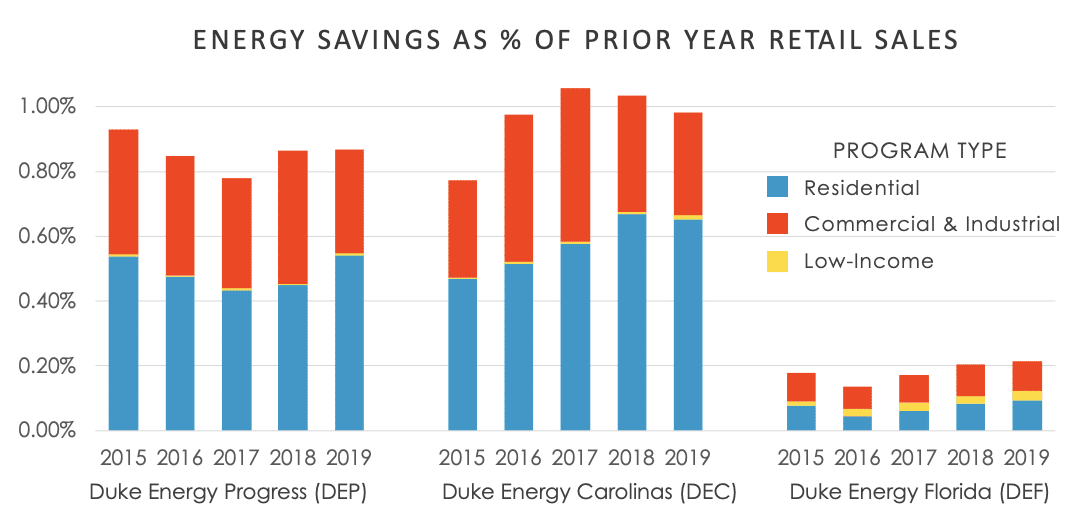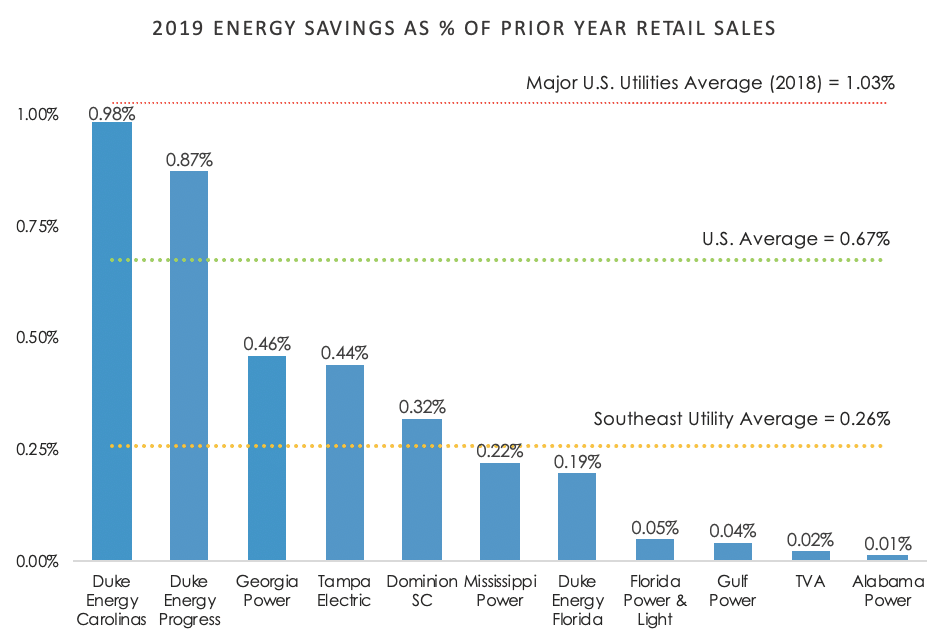Duke has outperformed its regional peers on efficiency for many years now, and in many ways is the best positioned to build on its past performance to reach new levels in the coming years.
Forest Bradley-Wright | February 19, 2021 | Energy Efficiency, Energy Policy, Florida, North CarolinaThis blog is part two in our review of Duke Energy’s energy efficiency performance as reported in SACE’s third annual “Energy Efficiency in the Southeast” report. Part one of this blog series compared Duke’s efficiency performance in North Carolina, South Carolina, and Florida to other utilities in the Southeast, and measured its efficiency performance against national leaders. This second part focuses on ways Duke can continue to increase its efficiency savings and strengthen the role of efficiency in its integrated resource planning.
Download the Report
Read the Report Series
Watch the report webinar
Energy efficiency is a large and multifaceted energy resource with the potential to solve many issues – everything from lowering customer bills, retiring outdated power plants, and reducing the need for new fossil generation, while cutting carbon emissions and creating new jobs and local economic development. Even for Duke, the Southeast’s regional leader, there is still tremendous untapped potential for efficiency. But developing and deploying successful programs to capture new energy savings takes utility commitment, flexibility, and problem-solving, alongside supportive regulatory policies. Duke has outperformed its regional peers on efficiency for many years now, and in many ways is the best positioned to build on its past performance to reach new levels in the coming years.

Where are the Additional Savings Opportunities for Duke?
Technologies, consumer preferences, and efficiency standards for buildings and appliances are frequently changing, so it takes consistent effort for utilities to sustain high levels of energy savings. More than any other utility in the Southeast, Duke has worked to keep savings levels up by developing new programs and finding new ways to enhance program delivery – much of it with help from Collaborative stakeholders like SACE.
New and Modified Programs
Over the past couple of years, Duke has initiated numerous efforts to add, modify, and expand efficiency programs in the Carolinas, including:
- Expanding participation and providing deeper savings through Duke Energy Carolina’s (DEC) Income-Qualified Weatherization program
- Adding new measures to its low-income focused Neighborhood Energy Saver program
- Expanding its successful Duke Energy Progress (DEP) Residential New Construction programs into DEC territory
- Transforming its Small Business Energy Saver program to include meter-based savings incentives and financing for commercial upgrades
- Identifying new measures to add to its midstream delivery channels
- Creating a demand response program to reduce winter demand peaks
- Committing to developing a program to allow customers to make larger investments in efficiency upgrades and pay for them over time on their monthly energy bills
These initiatives are currently in different stages of development, approval, and implementation, but all represent significant new areas of efficiency saving potential. Duke has a strong support system from advocates in the Carolinas to help implement and sustain these efforts. SACE continues to encourage the company to reach for higher savings, and regularly provides new program ideas, models, and delivery recommendations.
Improved Cost Effectiveness
As noted in Part 1, Duke has historically relied on the Total Resource Cost test to evaluate cost-effectiveness. Unfortunately, the test has long been applied in an asymmetrical way. Historically Dukes TRC analysis – as directed by previous Commission rules – included all costs (both those paid by the utility and the customer) and counted utility system benefits, but many of the benefits to customers were excluded. North and South Carolina’s Commission recently approved a switch to using the Utility Cost Test, which should lead to improved cost effectiveness and new savings opportunities.

Commercial and Industrial Savings
Across the country, some of the largest and most cost-effective efficiency savings come from the large commercial and industrial sectors. But for Duke in the Carolinas, this remains a huge and largely untapped savings opportunity. An extremely expansive interpretation of opt-out provisions has led to massive declines in efficiency savings for these customers in recent years. In testimony last year, SACE noted approximately 56% of DEP’s non-residential load opted out in 2019. For DEC 60% opted out. If instead of opting out, these customers had participated at comparable rates to all other customers, DEP’s annual efficiency saving for 2019 would have been 1.14% and DEC’s would have been 1.56%. Clearly, finding ways to re-engage these large commercial and customers represents one of the biggest future savings opportunities for Duke.
Integrated Resource Planning
Integrated resource planning (IRP) is a process through which utilities project future customer energy needs and analyze the best mix of resources to meet them – including a mix of traditional power generation, renewable energy, and energy efficiency. Duke in the Carolinas files a full IRP with the North and South Carolina Commissions every two years, and it files a simplified update in the intervening years. Because saving energy frequently costs less than building new power plans, energy efficiency is extremely valuable for resource planning. Despite this fact, most utilities in the Southeast downplay its availability and underinvest in efficiency resources. The chart below is from a recent report by the American Council for an Energy Efficient Economy showing that energy efficiency in North Carolina is considerably less expensive than building new power generation.

Over the past two years, the North Carolina Utilities Commission and the South Carolina Public Service Commission (PSC) have shown a growing desire to see higher levels of renewable energy and energy efficiency in integrated resource planning – in part to reduce carbon emissions and help retire outdated coal generators. In December 2020, the South Carolina PSC actually rejected an IRP filed by neighboring utility Dominion Energy, in a decision that could have important implications for Duke Energy as well. Dominion was ordered by the Commission to modify and refile its IRP in 60 days with higher levels of solar and energy efficiency.
Last September, Duke Energy Carolinas and Duke Energy Progress filed an Integrated Resource Plan (IRP) with both the North and South Carolina Commissions, but clean energy proponents (including SACE) filed testimony on February 5th, showing substantially higher efficiency savings opportunities and called on the utility to modify and resubmit its IRP with more energy savings.

Last year, the Florida Public Service Commission also showed new interest in integrated resource planning, but there is no clear path in current Florida law to establish requirements like those Duke must follow in the Carolinas.
Nevertheless, upcoming decisions on Duke’s IRPs in the Carolinas and Florida’s energy efficiency rule reform (currently underway) are two of the most important issues to watch in 2021 and could have significant implications for future energy efficiency savings at Duke. SACE submitted formal recommendations for improving Florida’s energy efficiency rules on February 15th, while over 600 SACE members have joined thousands of others in writing the Florida Commission in support of higher energy efficiency by visiting EnergySmartFL.com.

SACE applauds Duke for its achievements to date, while continuing to encourage it to pursue more energy efficiency investment. Despite leading the Southeast, Duke still has a long way to go to achieve leadership on a national scale. Fortunately, there are many options on the path to this goal, each with the potential to lower customer bills, reduce reliance on fossil fuels, and help Duke to achieve its corporate carbon reduction goals.
Find out more from our “Energy Efficiency in the Southeast” third annual report, blog series, and further resources below:
Download the Report
Read the Report Series
Watch the report webinar
Other Resources / Recent Reports
Last year, the American Council for an Energy Efficient Economy released a report focused specifically on North Carolina that identified numerous new efficiency strategies that could increase overall utility savings performance and help the state reach its carbon emissions reduction targets.
Last year, Duke Energy commissioned a novel winter peak study that leaned in on new ways that efficiency, demand response, and innovative rate designs could reduce peak energy demand during the winter months.
#SEEnergyEfficiencyReport2021